
Striking a balance between physical and virtual isn't a new conundrum. The introduction of e-books in the early 2010s took the publishing world by storm, forcing them to grapple with the implications of digital readers. While physical books didn't go the way of the dodo, the industry expanded its horizons and now enjoys the best of both worlds. In the same way that e-books became a permanent fixture, digital commerce is becoming an undeniable facet of sales.
As e-commerce thrives, business-to-business (B2B) sales are especially primed for virtual solutions than ever before. The Gartner Future of Sales 2025 report estimates that 80% of B2B sales will occur via digital channels. One effective virtual selling channel is the virtual sales room, an all-in-one platform designed to streamline virtual sales and create a secure place to conduct business transactions. Sales organizations may be wondering whether this is just the latest fad or if this new technology has staying power. Let's look at why virtual sales rooms are here to say.
Virtual sales rooms have become a crucial tool in the booming e-commerce industry. With the global e-commerce market valued at $6.3 trillion this year and expected to reach $6.51 trillion by 2023, businesses are embracing these online platforms to engage customers and drive sales. In the U.S. alone, the e-commerce market is worth $905 billion, further highlighting the significance of virtual sales rooms as a permanent fixture in retail. They provide convenience, efficiency, and cost-effectiveness, revolutionizing how businesses connect with customers and conduct transactions.
Why virtual sales rooms are here to stay
Virtual sales rooms are more than just a neat gadget or sales feature. Utilizing one in your organization could significantly impact sales numbers and reaching quotas. Several key features enable teams and organizations to streamline and personalize their sales pipeline like never before. Here's how virtual sales rooms make that possible and why they're here to say.
Virtual sales rooms are scalable for sales teams
One of the primary reasons that virtual sales rooms are staying long-term is due to their scalability. The math is simple. Virtual sales rooms can reach more people while costing less money. In-person sales also take a remarkable toll on a company's finances. The cost of booth rentals, marketing materials, and signage can add up quickly, not to mention that sending a sales rep to a showcase or to meet with a client often requires airfare and per diem for lodging and food. According to the Global Business Travel Association, the global annual spend on business travel peaked at $1.3 trillion in 2019. Going virtual can allow businesses to repurpose this money toward new sales representatives, better virtual technology, and additional training while also maximizing their employees' time.
Though experts expect the slow-down of business travel to recover fully by 2024, many companies will likely continue with some aspect of remote work and online communication thanks to the many conveniences. This transition gives businesses moving into virtual sales rooms several advantages. First, past clients may be more technologically savvy or inclined than they were previously. Second, virtual sales rooms allow for remote sales, so businesses can continue selling without spending time or money on travel. Third, with a completely remote sales process, you could cut the costs of supporting an office building.
They offer flexibility for buyers and sellers

In-person sales drag on your customers' time and money too. A tremulous economy and high turnover rates are already sapping company resources. Workers are taking on extra roles, pivoting departments, and adapting to technology and remote work. While uncertainty prevails, flexibility and convenience become essential. Virtual sales rooms provide that for everyone. Logging onto a secure platform to collaborate with a customer takes minutes instead of the hours it takes coordinating meetings or sending contract PDFs back and forth through multiple rounds of edits.
A virtual sales room also allows sales reps to expediently answer buyer questions or share materials. Bouncing emails back and forth is possible, but it lacks the human touch digital sales rooms make possible. The face-to-face interaction can also make the conversation more approachable than a phone call. Additionally, looking someone in the eye, reading their body language, and offering a friendly smile can go a long way in making a sale.
Employees can also benefit from this level of flexibility. As we mentioned above, going virtual can allow employees to work remotely, an appealing prospect for many workers. With a computer and internet connection, they can connect securely from anywhere they choose. Lastly, virtual sales rooms can bring together customers from different regions, countries, and time zones. They allow a company to bring together several stakeholders in the "room" or let your rep "travel" across the world in a few hours. For instance, they could talk to someone in London at 8 a.m., then in New York at 9 a.m., Montreal at 10 a.m., and Los Angeles at 11 a.m.
Virtual sales rooms provide a unified buyer experience
How many stakeholders does it take to make a purchasing decision? According to research on modern business practices, the average is 6.8. It's no simple feat for sales teams to wrangle six or seven decision-makers for an in-person meeting to make a pitch, discuss a proposal, or receive a final decision. However, keeping everyone on the same page is crucial to success since disconnected stakeholders may be prone to poor decisions. Unfortunately, this is easier said than done.
Often, sales teams need to perform scheduling gymnastics or risk last-minute drop-outs, which can lead to miscommunication and a compromised sale. Luckily, virtual sales rooms can help create a unified experience for all parties. Instead of spending weeks trying to coordinate multiple schedules for several in-person meetings, sellers can create and share a live link for a single source of truth, including all relevant information to the deal and negotiation and opportunities to chat with sellers in real-time.
Instead of bouncing emails around, losing attachments, and sending reminders, using a virtual sales room centralizes sales materials and communication channels. Now, all interested parties can engage with the content on one platform and ask specific questions through chat channels. With customization features, the materials can also be personalized to add a unique and humanized touch that can help drive sales and expedite the decision-making process.
Access detailed analytics about deal progress
Another powerful component of virtual sales rooms is their advanced analytics. Drawing usable data from in-person sales visits, phone calls, or emails can be exceptionally difficult. Virtual sales calls make it easier to track details such as click-throughs and time spent on materials. With this technology, you can obtain real-time insights on how potential customers engage with proposals, use forwarded content to map new stakeholders, and consolidate the sales process by quick action and responses.
Analytics can also help you improve your sales team's results. Use data to improve the accuracy of forecasts. Learn the strengths and weaknesses of each team member. Find areas where they need improvement so you can prescribe any necessary coaching or a representative backup for the account. By harnessing the power of analytics, you can create a team of sales leaders who all meet or even exceed their quotas.
Analytics allows you to keep track of your progress too. Oversee the status of all your active sales, whether they were just sent, recently opened, reviewed, or signed. You can also keep tabs on whether a document was downloaded, printed, or commented on. Artificial intelligence (AI) features can also be used to automate reminders, follow-up emails, or SMS messages.
A virtual sales room saves time

The way virtual sales rooms help sales teams save time is a big part of their appeal. The time it takes to go to and from in-person sales meetings can add up quickly, even if all the meetings are local. On the other hand, virtual sales rooms allow sales teams to spend more energy selling than traveling. Additionally, sales rooms include features that can help streamline the content creation process effectively.
Producing sales materials from scratch is time-consuming and expensive, especially if you need to hire a designer to develop everything you make. That's where personalized templates come in. Templates are frameworks that allow you to streamline the creation process. You can implement them over and over again without repeating any unnecessary tasks to craft fresh pieces. With a good design, updating a document can be as simple as inserting the customer's name, a title or subject line, and any necessary details specific to the client at hand. By creating a few essential templates, you can add a personal touch while maintaining efficiency.
GetAccept's content library and editing features allow you to save your current documents as professional templates. It grants access to your entire team so they can edit your templates for their individual clients and proposals. Complementary templates can also be designed for various assets to ensure brand consistency across your materials. If you wish to create new workable templates from scratch, GetAccept offers free proposal templates to help simplify a considerable part of the process, giving you more time to customize the content and check the most important details.
DSRs personalize the sales experience
Virtual and digital sales rooms are more than just a video conference call. The potential for personalizing the sales experience is a big reason why virtual sales rooms are here for the long haul. By choosing a robust virtual platform, you can dazzle your customers with case studies, videos demos, customized proposals, and company presentations. Centralizing these marketing materials reinforces the sales message and sharpens your edge over the competition.
Adding engaging communication features can improve your hit rates up to 30%. So, instead of using a drab email that's bound to get lost in an inbox, you can automate a message that pops up after a proposal to keep things moving. You could also utilize a live chat feature to give customers a way to ask any pertinent questions. Selfie introductory videos are another great way to engage with customers. Whether it's a custom video welcome, pitch, follow-up, or testimonial, seeing a person's face humanizes virtual sales in a meaningful way.
Not sure how to create all these customized materials? All-in-one content creation is an essential feature of any virtual sales platform. GetAccept offers many features to help sales teams develop specialized marketing materials. Plus, GetAccept documents get about a 66% hit rate. You can even track your own data with advanced document tracking and analytics.
5 signs your company could benefit from a virtual sales room

A virtual sales room is an amazing tool, but you may be unsure if it is a good fit for your company. If you're on the fence, here are five ways to gauge whether a virtual sales room is right for your organization:
- You handle many accounts and sales reps: If you're working with a multitude of clients or a robust sales force, then it may be time to join the virtual sales room bandwagon. Utilizing this tool will help coordinate and streamline all of your accounts and reps, letting them work more efficiently and allowing you to keep track of multiple accounts.
- Your clients gravitate to remote sales: If you're fielding frequent requests for video conferencing, e-commerce options, or other digital tools, then your clients may be indirectly asking you to advance your digital options.
- Your company or clients recently went remote: If your sales staff and clients recently started working remotely, this may be the perfect time to spring for a virtual sales platform. Your new platform could help you coordinate your sales teams while also affording your newly remote clients a digital upgrade they will want to work with.
- You want to increase virtual sales: If you're looking to break into virtual sales, then a virtual sales room is the perfect platform to springboard your new virtual selling efforts.
- You need help closing deals more efficiently: Since most businesses make purchases by committee, scheduling interferences and coordination can lead to poor return on investment (ROI) or even lost sales. Utilizing a virtual platform can help your sales force connect with all necessary stakeholders at the same time and reduce languishing wait periods.
If you resonated with even one of these qualifications, then it may be time to start inquiring about a digital sales room, and GetAccept could be just what you need to get started!
Book a demo with GetAccept
Virtual sales rooms are here for the long haul. Scalability, flexibility, unified experiences, advanced analytics, salvaged time, and personalizing features are just a few of the reasons why they're here to stay. Whether it's to accommodate your accounts and sales team or maximize your virtual selling, a virtual sales room can take your sales organization to the next level. Choosing GetAccept is the perfect way to invest in this bright new future.
With our robust technology and elite support staff, you'll be on your way toward closing deals and upgrading your sales pipeline. Request a demo of GetAccept to see how we can meet your business's unique goals and needs.
If you're ready to elevate your sales process, book your demo here.




